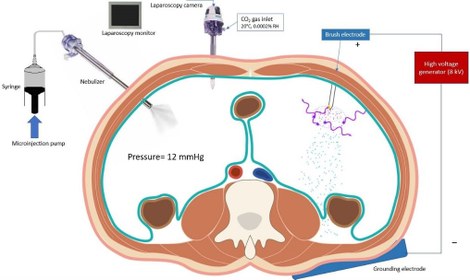Intraperitoneal drug delivery using aerosols
Pressurized IntraPeritoneal Aerosol Chemotherapy (PIPAC)
Peritoneal metastasis (Figure 1) is common in several forms of abdominal cancer. It is a type of gastrointestinal and non-gastrointestinal cancers that affects and spreads into the peritoneum. A recent and innovative drug delivery platform called Pressurized IntraPeritoneal Aerosol Chemotherapy (PIPAC) was developed to treat patients with peritoneal metastasis using laparoscopy (Figure 2). Using PIPAC, chemotherapeutics are nebulized into the peritoneal cavity to create aerosol droplets for a more homogenous distribution. The possibility to repeat the procedure, its minimally invasive approach and morbidity are some of its advantages.
PIPAC technique
During PIPAC (Figure 2), a CO2 pneumoperitoneum is established (12-15 mmHg) to inflate the abdominal cavity. Then, a drug-containing solution is aerosolized within the inflated abdominal cavity by means of a microinjection pump (MIP®) in combination with a high-pressure injector. The aerosol droplets behaviour and transport into the cavity is monitored through a camera (Laparoscopy).
Electrostatic Precipitation Pressurized IntraPeritoneal Aerosol Chemotherapy (ePIPAC)
Preclinical PIPAC experiments suggest that the aerosol distribution is not uniform throughout the cavity. By considering additional forces, such as the electrostatic force, it may be possible to overcome the gravity force effect and improve the distribution in the abdominal cavity. EPIPAC (see Figure 3) includes an electrical generator with an electrode and a ground plate to create an electrostatic field in the abdominal cavity in order to optimize the deposition behavior of charged aerosol droplets [1,2].
The first step of the current project is the performance of in-vitro experiments and computational fluid dynamics (CFD) simulations using a plexiglass box model, mimicking the patient’s abdominal cavity. The second step is working on a rat model. CFD models certainly decrease the time and costs compared to experimental models and have obtained a significant interest in the medical engineering field because of its non-invasive character. The use of a CFD model may generate important insights in how treatment parameters affect aerosol droplets distribution during (e)PIPAC, and how they can be optimized. The current project runs in close collaboration with the Department of Human Structure and Repair (Prof. Wim Ceelen- Director of Experimental Surgery lab) and IBiTech– bioMMeda. In this work, a numerical PIPAC and ePIPAC modelling technique is developed to investigate the effects of significant effective parameters on the homogeneity of aerosol droplets delivery and distribution in the peritoneal cavity by using CFD. Figure 4 showed an overview of the current project.

IBiTech researchers currently active on the project
- Mohammad Rahimi Gorji (contact)
- Charlotte Debbaut (contact)
- Wim Ceelen (Department of Human Structure and Repair, UGent) (contact)
- Ghader Ghorbaniasl (Department of Mechanical Engineering, VUB)(contact)
Funding sources
- Special Research Fund from Ghent University [BOFGOA2016000801]
References
- Mohammad Rahimi-Gorji, Leen Van de Sande, Charlotte Debbaut, et al., Intraperitoneal aerosolized drug delivery: Technology, recent developments, and future outlook, Advanced Drug Delivery Reviews, Vol 160, 2020, 105-114 (link).
- Leen Van de Sande, Mohammad Rahimi‐Gorji, et al., Electrostatic Intraperitoneal Aerosol Delivery of Nanoparticles: Proof of Concept and Preclinical Validation, Advanced Healthcare Materials, 2020, https://doi.org/10.1002/adhm.202000655 (link).


